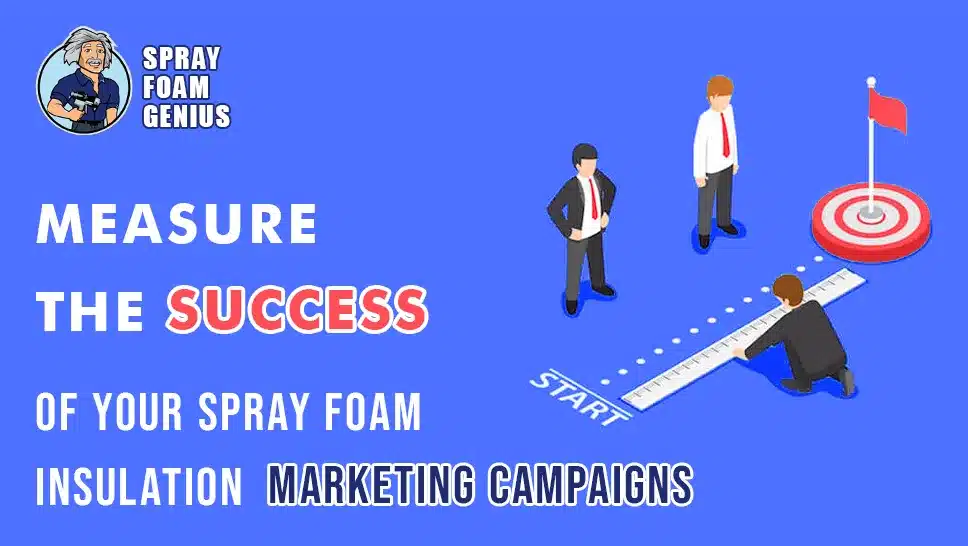
In today’s competitive market, understanding how to measure the success of your spray foam insulation marketing campaigns is crucial. Effective measurement not only helps in refining your strategies but also ensures that you are making informed decisions to achieve your business goals. At Spray Foam Genius Marketing, we specialize in providing tailored marketing solutions for spray foam insulation contractors across the USA and Canada. This guide will walk you through the essential metrics, analysis techniques, and actionable strategies to evaluate and enhance your marketing efforts.
The Importance of Measuring Marketing Success
Why Measure Marketing Success?
Measuring the success of your marketing campaigns provides several benefits:
- Budget Optimization: Understanding which campaigns drive the best results allows you to allocate your budget more effectively, ensuring that you are investing in the most profitable channels.
- Strategy Improvement: Tracking performance helps identify what’s working and what isn’t, allowing for adjustments and refinements to improve overall effectiveness.
- ROI Justification: Calculating the return on investment (ROI) from your marketing efforts helps justify expenditures and demonstrates the value of your marketing activities to stakeholders.
- Competitive Edge: Measuring success allows you to stay ahead of the competition by adapting quickly to market changes and customer preferences.
Essential Metrics to Track
To accurately gauge the success of your marketing campaigns, focus on these key metrics:
1. Website Traffic
Why It Matters: Increased website traffic often signifies that your marketing strategies are attracting more potential customers to your site.
How to Measure:
- Total Visits: Track the total number of visits to your website over a specific time frame.
- Unique Visitors: Measure the number of individual users visiting your site. This helps in understanding your reach.
- Traffic Sources: Identify where your traffic is coming from—whether it’s organic search, paid ads, social media, or referral links.
Tools: Use Google Analytics to monitor traffic patterns, track visitor behavior, and gain insights into how users interact with your site.
Additional Considerations:
- Bounce Rate: Analyze the percentage of visitors who leave your site after viewing only one page. A high bounce rate may indicate that your landing pages are not engaging enough.
- Average Session Duration: This metric shows how long visitors stay on your site, providing insight into the quality of your content and user experience.
2. Conversion Rate
Why It Matters: Conversion rate measures how effectively your website turns visitors into leads or customers. It’s a crucial indicator of the effectiveness of your marketing campaigns and website design.
How to Measure:
- Form Submissions: Track the number of contact forms or quote requests submitted through your website.
- Phone Calls: Measure the number of phone calls received as a result of your marketing efforts. Use call tracking software to attribute calls to specific campaigns.
- Purchases or Sales: For those with e-commerce capabilities, track the number of completed transactions.
Tools: Google Analytics and CallRail are useful for tracking conversions and analyzing customer interactions.
Additional Considerations:
- Lead Quality: Evaluate the quality of leads generated to ensure they meet your business criteria.
- Conversion Path Analysis: Understand the journey visitors take before converting, which can help identify effective touchpoints and areas for improvement.
3. Cost Per Lead (CPL)
Why It Matters: CPL measures the cost associated with acquiring each lead, helping you assess the efficiency of your marketing spend.
How to Measure:
- Formula: Total Campaign Cost / Number of Leads
- Analysis: Compare CPL across different campaigns to identify which channels are most cost-effective.
Tools: Google Ads and Facebook Ads Manager provide insights into CPL and overall campaign performance.
Additional Considerations:
- Lead Volume vs. Quality: Balance between the number of leads and their quality. Sometimes a higher CPL might be justified if it results in high-quality leads.
4. Return on Investment (ROI)
Why It Matters: ROI provides a clear measure of the profitability of your marketing campaigns. It helps ensure that your marketing efforts are yielding a positive financial return.
How to Measure:
- Formula: (Revenue from Campaign – Cost of Campaign) / Cost of Campaign
- Analysis: Evaluate the ROI to ensure that your marketing campaigns are generating more revenue than their cost.
Tools: Use Google Analytics and CRM Software to track revenue and calculate ROI.
Additional Considerations:
- ROI by Channel: Analyze ROI for different marketing channels to identify the most profitable ones and adjust your budget accordingly.
5. Customer Acquisition Cost (CAC)
Why It Matters: CAC measures the total cost associated with acquiring a new customer. Understanding CAC helps in evaluating the efficiency of your marketing spend.
How to Measure:
- Formula: Total Marketing Costs / Number of New Customers Acquired
- Analysis: Keep CAC as low as possible while maintaining the quality of leads and customers.
Tools: Google Analytics and CRM Software can help track CAC and provide insights into marketing expenses.
Additional Considerations:
- CAC vs. CLV: Compare CAC with Customer Lifetime Value (CLV) to ensure that your customer acquisition efforts are profitable in the long term.
6. Customer Lifetime Value (CLV)
Why It Matters: CLV measures the total revenue a customer is expected to generate during their relationship with your business. It helps assess the long-term value of your marketing efforts.
How to Measure:
- Formula: Average Purchase Value x Number of Repeat Sales x Average Customer Retention Time
- Analysis: Ensure that CLV exceeds CAC to achieve profitability and sustainable growth.
Tools: CRM Software and Google Analytics can help calculate CLV and track customer interactions.
Additional Considerations:
- CLV Segmentation: Analyze CLV by different customer segments to identify high-value customers and tailor your marketing efforts accordingly.
Analyzing Campaign Performance
Benchmarking: Compare your current metrics against historical data or industry benchmarks to assess performance. This helps in setting realistic goals and measuring progress.
Segmentation: Break down data by different segments such as demographics, traffic sources, or marketing channels to identify which segments perform best. This helps in targeting the right audience more effectively.
A/B Testing: Conduct A/B tests on various elements of your campaigns (e.g., headlines, call-to-action buttons) to determine what resonates most with your audience. This method allows for data-driven decision-making and optimization.
Customer Feedback: Gather feedback from customers to understand their experience and identify areas for improvement. This qualitative data complements quantitative metrics and provides a fuller picture of campaign effectiveness.
Adjusting Your Strategy

Based on your analysis, make informed adjustments to your marketing strategy:
1. Optimize Campaigns
Focus on channels and tactics that yield the highest ROI and CPL. Allocate more budget to high-performing areas and refine or eliminate underperforming ones.
2. Refine Targeting
Use insights from customer data to better target your audience. Improve the relevance of your marketing messages and tailor your campaigns to meet the needs and preferences of your target market.
3. Enhance Content
If certain types of content (e.g., blog posts, videos) perform better, create more of those to drive engagement and conversions. Invest in high-quality content that resonates with your audience.
4. Improve User Experience
Ensure that your website and landing pages are optimized for conversions. Provide a seamless experience for visitors, including fast loading times, intuitive navigation, and clear calls to action.
Tools and Resources
To effectively measure and analyze your marketing campaigns, leverage the following tools:
- Google Analytics: Offers comprehensive insights into website traffic, user behavior, and conversion tracking.
- Google Ads: Provides detailed data on ad performance, cost per lead, and ROI.
- SEMrush: Useful for competitive analysis, SEO metrics, and keyword performance.
- CallRail: Tracks phone call conversions and attributes calls to specific marketing campaigns.
- HubSpot: CRM software that helps in managing customer interactions and tracking marketing performance.
Take Action Today!
Your marketing campaigns are a crucial investment in your spray foam insulation business. By effectively measuring and analyzing their success, you can make data-driven decisions that lead to increased leads, conversions, and ultimately, revenue.
Ready to elevate your marketing strategy? Call us at 877-840-FOAM for USA and 844-741-FOAM for Canada visit our website at sprayfoamgeniusmarketing.com, or email us at [email protected] to get started.
Let’s work together to drive exceptional results for your business!
- 5 Google My Business Hacks to Double Your Leads for Spray Foam Insulation Contractors - January 14, 2025
- Why Spray Foam Contractors Cannot Ignore Reputation Management in 2025 - January 13, 2025
- Local SEO Secrets Every Spray Foam Contractor Must Know to Win in 2025 - January 13, 2025

